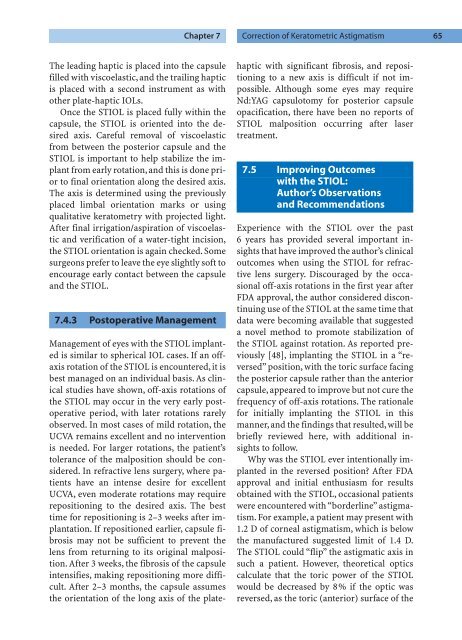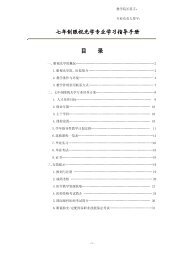Refractive Lens Surgery
Refractive Lens Surgery
Refractive Lens Surgery
Create successful ePaper yourself
Turn your PDF publications into a flip-book with our unique Google optimized e-Paper software.
The leading haptic is placed into the capsule<br />
filled with viscoelastic, and the trailing haptic<br />
is placed with a second instrument as with<br />
other plate-haptic IOLs.<br />
Once the STIOL is placed fully within the<br />
capsule, the STIOL is oriented into the desired<br />
axis. Careful removal of viscoelastic<br />
from between the posterior capsule and the<br />
STIOL is important to help stabilize the implant<br />
from early rotation, and this is done prior<br />
to final orientation along the desired axis.<br />
The axis is determined using the previously<br />
placed limbal orientation marks or using<br />
qualitative keratometry with projected light.<br />
After final irrigation/aspiration of viscoelastic<br />
and verification of a water-tight incision,<br />
the STIOL orientation is again checked. Some<br />
surgeons prefer to leave the eye slightly soft to<br />
encourage early contact between the capsule<br />
and the STIOL.<br />
7.4.3 Postoperative Management<br />
Management of eyes with the STIOL implanted<br />
is similar to spherical IOL cases. If an offaxis<br />
rotation of the STIOL is encountered, it is<br />
best managed on an individual basis. As clinical<br />
studies have shown, off-axis rotations of<br />
the STIOL may occur in the very early postoperative<br />
period, with later rotations rarely<br />
observed. In most cases of mild rotation, the<br />
UCVA remains excellent and no intervention<br />
is needed. For larger rotations, the patient’s<br />
tolerance of the malposition should be considered.<br />
In refractive lens surgery, where patients<br />
have an intense desire for excellent<br />
UCVA, even moderate rotations may require<br />
repositioning to the desired axis. The best<br />
time for repositioning is 2–3 weeks after implantation.<br />
If repositioned earlier, capsule fibrosis<br />
may not be sufficient to prevent the<br />
lens from returning to its original malposition.<br />
After 3 weeks, the fibrosis of the capsule<br />
intensifies, making repositioning more difficult.<br />
After 2–3 months, the capsule assumes<br />
the orientation of the long axis of the plate-<br />
Chapter 7 Correction of Keratometric Astigmatism 65<br />
haptic with significant fibrosis, and repositioning<br />
to a new axis is difficult if not impossible.<br />
Although some eyes may require<br />
Nd:YAG capsulotomy for posterior capsule<br />
opacification, there have been no reports of<br />
STIOL malposition occurring after laser<br />
treatment.<br />
7.5 Improving Outcomes<br />
with the STIOL:<br />
Author’s Observations<br />
and Recommendations<br />
Experience with the STIOL over the past<br />
6 years has provided several important insights<br />
that have improved the author’s clinical<br />
outcomes when using the STIOL for refractive<br />
lens surgery. Discouraged by the occasional<br />
off-axis rotations in the first year after<br />
FDA approval, the author considered discontinuing<br />
use of the STIOL at the same time that<br />
data were becoming available that suggested<br />
a novel method to promote stabilization of<br />
the STIOL against rotation. As reported previously<br />
[48], implanting the STIOL in a “reversed”<br />
position, with the toric surface facing<br />
the posterior capsule rather than the anterior<br />
capsule, appeared to improve but not cure the<br />
frequency of off-axis rotations. The rationale<br />
for initially implanting the STIOL in this<br />
manner, and the findings that resulted, will be<br />
briefly reviewed here, with additional insights<br />
to follow.<br />
Why was the STIOL ever intentionally implanted<br />
in the reversed position? After FDA<br />
approval and initial enthusiasm for results<br />
obtained with the STIOL, occasional patients<br />
were encountered with “borderline” astigmatism.<br />
For example, a patient may present with<br />
1.2 D of corneal astigmatism, which is below<br />
the manufactured suggested limit of 1.4 D.<br />
The STIOL could “flip” the astigmatic axis in<br />
such a patient. However, theoretical optics<br />
calculate that the toric power of the STIOL<br />
would be decreased by 8% if the optic was<br />
reversed, as the toric (anterior) surface of the



